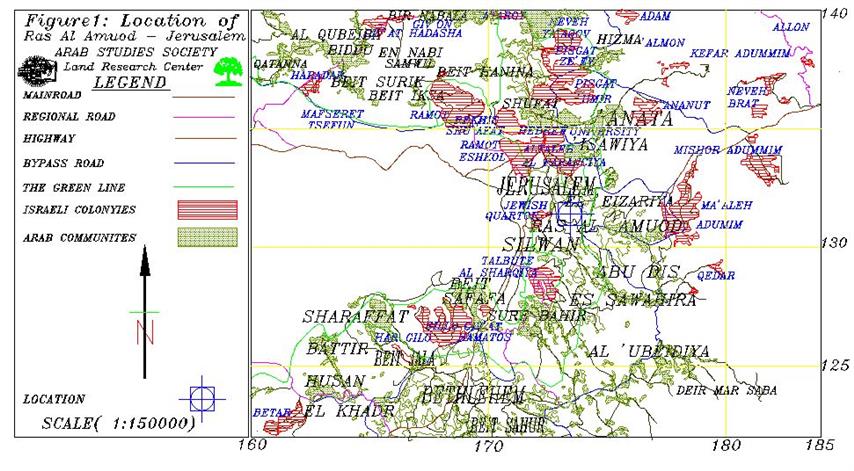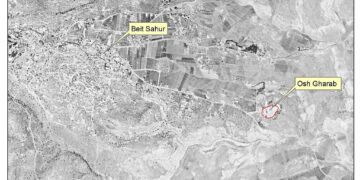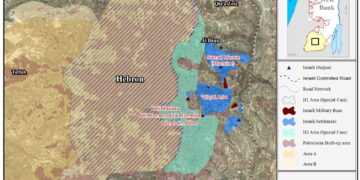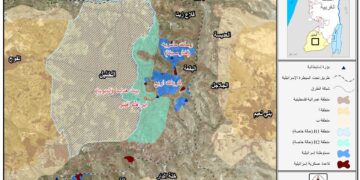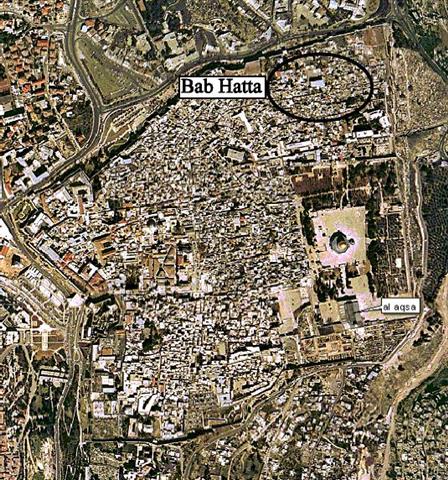Ras El-Amoud neighborhood is located in East Jerusalem's basin number 7 and parcel number 119 according to Jordanian classification and basin number 29989 and parcel number 96 according to Israeli classification.The area of the overlapped Ras El-Amoud and Silwan neighborhoods is about 1600 dunums. The area of the lot that was reserved for the settlement activity is about 13.8 dunums. As for the population, there are about 11,000 Palestinians living in this suburb. Up until 17-9-1997, no Jewish population was present in the suburb.
The late Hussein El Ghoul family has been using the land since 1837. The family didn't comply with the Ottoman rule regarding land registration that was issued in 1859. Taking advantage of this fact and the fact that the British Mandate authorities were sympathetic with the Jews, two Zionist movements (Habad and Fahlin) registered the same piece of land in their names in 1928. This registration took place without informing El Ghoul family who continued living in and benefiting from the land. During the Jordanian rein over the West Bank, and according to the sole registration of the site for Habad and Fahlin movements, this land was registered in the in the department of 'Custodian of Enemy Properties' (CEP). Based on that fact, and due to the Jordanian relevant authority's refusal to register the land for the family, the representative of El Ghouls sued the CEP and the case was held up in the courts until 1962. In that year both the appeal and the distinction courts recognized the ownership of El-Ghoul family of the land and registered it officially in the name of the family.
Distribution and registration of the land after the 1962 court ruling:
The land was divided into 16 parts distributed and registered as follows:
-
Six parts for Our Father Ibrahim Monastery ( Albendekation Monestary for Mr. Jad Khaleel Michael),
-
One part sold to Mr. Daoud Al Bitar and his wife,
-
One part sold to Mr. Musa Zacky Al Ayoubi,
-
One part that had a house built on for Mr. Khaleel Al Silwani hadia. The piece of land stayed registered to the original owner Mr. Ahmad Hussein El-Ghoul, and
-
Seven parts remained registered to Mr. Ahmad Hussein El-Ghoul.
The issue of taking hold of the piece of land:
After the Israeli occupation of the West Bank in 1967, Habad and Fehin societies sued the owners and users of the land. The societies relied on the registration decree issued in 1928 during the British Mandate. They have ignored the decision of the Jordanian Appeal and Distinction courts. The Israeli Central Court issued a decree canceling the Jordanian registration and considered the land as a disputed one. That was the first stage in the taking hold process.
When the suburb people submitted a master plan of Ras El-Amoud and Silwan to Jerusalem Municipality, the Municipality deterred adopting this master plan for long years claiming that this suburb has a land belonging to the Jewish people. The condition imposed by the Municipality to adopt this master plan is the acceptance of the suburb people to establish a Jewish colonial complex on the land. This policy led to a number of house demolishing and prevented new building in the neighborhoods. In 1997, the inhabitants of the neighborhood were surprised by the declaration of settlement plan number 4689 on the contested land located at the center of Ras El-Amoud. Although this land is part of the general master plan for the entire neighborhood, the Municipality approved the plan only for the settlement part and left the rest of the master plan without approval. When the approval finally was issued, inhabitants discovered that it didn't allow Arabs to build on more that 55-65% of the area of the land and with a maximum of two floors. On the other hand, the Municipality allowed for the Jews to build on 115% of the area of the land with a maximum of seven floors.
The start of Israeli atrocities against the neighborhood:
As soon as the decision of the building and planning committee of Jerusalem Municipality approving the settlement in Ras El-Amoud on 17-9-1997 was issued, some Jewish families took hold of the house built on the land of Mr. Ahmad Hussein El-Ghoul. A wave of condemnation and on-site protest erupted against the take over. Israeli peace movements took part in these protests. The Israeli forces punished the protesters in a savage way and protected the colonizers and prevented their expulsion from the site. Due to the escalation of the confrontation, the Israeli Authority declared that it reached an agreement with the Jewish colonizers leading to the evacuation of 5 families and letting 5 students to live in the place instead of them in the house previously occupied by the family of Fuad Hadiya. In the process, they have refused to allow the previous inhabits of the house to come back and live in the house. As to complicate things even further, an Israeli Border Guards squad closed the area with security siege to protect the Jewish students.
At the beginning of November 1998 the Jewish settlers started excavating the land using large caterpillars to prepare it for building. The Israeli Authorities claimed that this excavation is implemented for purposes of antiquity search. In reaction, another wave of Palestinian protests erupted and led to Israeli violent that reached its peak in hitting members of the Palestinian Legislative Council and arresting a number of Israeli and Palestinian peace activists.
Netanyahu Freezes building and Barak allows it:
Despite being an outspoken supporter of colonization activities, Benjamin Netanyahu was obliged to issue a decision freezing the colonial building in Ras El-Amoud awaiting the results of the Israeli elections on 17-5-1999. Moreover, although the leaders of the Labor Party strongly condemned the establishment of Jewish settlements, as soon as Mr. Barak bore the responsibilities as Israel's Prime Minister he gave the green light to continue building in this provocative project. On the contrary of his promises to the Americans that he will freeze the project, the building in the project is taking place in an accelerated rate to create yet another fact on the ground.
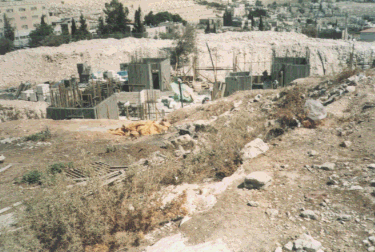
Initial building on the settlement of Ras El Amoud
Risks of establishing a Jewish settlement in Ras El-Amoud:
Although all colonial activities are illegal, Jewish colonial activity in Ras El-Amoud has extra risks associated with it. They include:
-
Arabs densely populate Ras El-Amoud neighborhood. This fact will lead to daily provocative interaction, threatening the stability and security in the region.
-
This new colonizing site is a unit among a chain of settlements closing the eastern exit of old Jerusalem. This exit is linking the Old City with Arab communities in Silwan, Abu Deis, El Aizariyah, and Al Shaiyah. The closure of this exist will make reaching the religious Islamic and Christian sites more complex and cumbersome.
-
The establishment of this settlement will lead to intensifying the presence of military personnel, checkpoints, and closures.
-
The settlement will lead to a tight siege from the southern end of Al Aqsa mosque especially when connected with the Jewish building plan in the northern slope of Silwan neighboring Al Aqsa wall.
-
The plan aims at vacating two more Palestinian families. These are the families of Khalid and Ahmad Hamd Allah families residing in this site for more than 50 years.
The settlement:
Ras El-Amoud settlement is planned to have the following:
-
133 urban units
-
1 commercial center
-
1 Jewish temple
-
1 kindergarten.
Coincidences?
While studying this case, we have noticed the following:
-
The Jewish millionaire Dr. Irving Moskovitch visited the sitof Ras El-Amoud settlement for the first time in 1997 on the anniversary of the Oslo agreement
-
Excavation works started on the day the Wye River Agreement was signed
-
Work started on the basic infrastructure of the settlement on the day Sharm El Sheikh Agreement was signed.
It is evident that the matching of these actions with these dates is no accident. It reflects the Israeli understanding of the peace process.. Peace on Paper. Facts of the Ground.
Prepared by:
The Land Research Center
LRC


